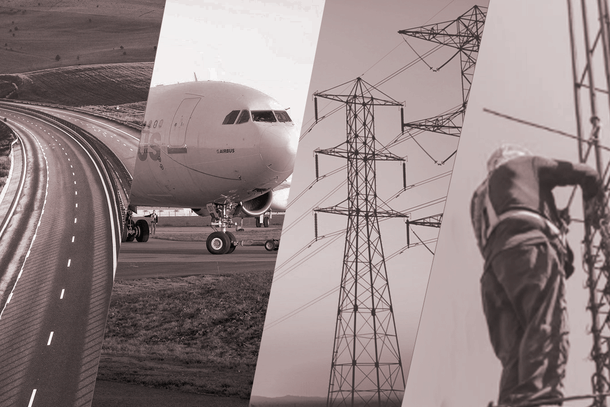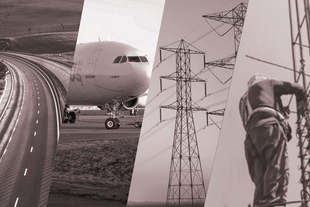Economy
Explained: The National Infrastructure Pipeline, Modi Government’s Rs 102 Lakh Crore Plan For Mega Infra Push
Aashish Chandorkar
Jan 02, 2020, 11:08 AM | Updated 04:26 PM IST
Save & read from anywhere!
Bookmark stories for easy access on any device or the Swarajya app.


In the 2019 Independence Day speech made by Prime Minister Narendra Modi, a key announcement was investment of Rs. 100 lakh crore in infrastructure over the next five years.
This was also one of the promises made in the Bharatiya Janata Party (BJP) manifesto for the Lok Sabha elections held in April and May 2019.
Following the announcement by the PM, a task force was constituted within the Finance Ministry to create a roadmap for this investment.
Officials from the Departments of Economic Affairs and Expenditure in the Finance Ministry and NITI Aayog were part of this task force.
The report of this body was presented on 31 December 2019 by Finance Minister Nirmala Sitharaman.
This report, called the National Infrastructure Pipeline (NIP), distils the sectoral investment plans and outlines a specific mission to achieve through this investment.
Apart from the obvious step of outlining the details, the report also identifies facilitating design, development and maintenance of public infrastructure as per global standards a priority for national infrastructure.
The report also calls out the need for enabling regulatory and administrative reforms to achieve the NIP ambition.
There are three significant parts to this report.
Firstly, the report identifies five specific reasons why Indian infrastructure needs an overhaul. These reasons include urbanization (42 per cent of population to live in urban areas in 2030 as opposed to 31 per cent now), growing working-age population (1.03 billion workforce projected in 2030), urban contribution to employment (41 per cent of the total by 2030), shift to services-based economy (share of agriculture to go down to 8 per cent from current 15 per cent) and climate change and disaster resilience.
The specificity of the factors driving the need for better infrastructure is well laid out.
Secondly, the NIP takes a broad view of what’s included in infrastructure development. Social infrastructure areas including higher education, school education, health and family welfare, sports and tourism are specifically called out.
Thirdly, for each sector, a general vision of the year 2025 has been painted. This vision includes not just the end state of the NIP, but also a few pointers on how the governance and the administration of the sector looks like.
These pointers can then form the basis for the regulatory reforms needed between now and 2025 to ensure that the full NIP benefits are realised.
The following chart shows the sector-wise break-up of the NIP. Five areas of investment – roads, urban housing, railways, power and irrigation constitute more than 80 per cent of the investment plan.

The NIP makes it clear that the plan includes investments made not just by the central government, but also by the state governments and the private sector.
The inclusion of state governments’ investments and private sector investments does not mean that the central government won’t ramp up its share.
In FY 2019, India’s total infrastructure investments were about Rs. 10 lakh crore, wherein the central government contributed Rs. 3.8 lakh crore, state governments Rs. 3.7 lakh crore and the private sector Rs. 2.5 lakh crore.
Achieving a Rs. 100 lakh crore spend in the next six financial years still means adding Rs. 40 lakh crore extra to the cumulative six years figure of Rs. 60 lakh crore based on FY 2019 run rate. This is a significantly new addition to the infrastructure pipeline.
The following figure shows how the NIP will be funded and the expected contributions in future between the three types of funders.

The sector-specific details are interesting as well. The following chart shows the investment outlay for each sector.

The top five sectors have all been set stretch targets along with clearly outlined need for legislative reforms and executive decisions.
Energy: India aims to take the current installed power capacity of 356 GW to 619 GW in the NIP period. The share of thermal installations is expected to go down from 66 per cent to 50 per cent.
The investments earmarked for nuclear power are interesting – with more than Rs. 1.5 lakh crore investment planned for nuclear power, India can easily add up to 15 GW in this space incrementally.
The NIP categorically calls for open access in distribution, regular tariff revisions and extensive metering using smart meters. Energy sector will get about 24 per cent of the total investments.
Roads: 19 per cent of the investments will be channelised to this sector. The target is to add 50 per cent total length to the existing National Highways, with 12x more Expressways constructed.
Given that the Bharatmala project has already identified some ambitious projects, the target looks attainable.
Additionally, the ownership of roads will tilt in favour of asset aggregators and financial investors as opposed to the public authorities today.
Urban and Housing: This is a big focus area for showcase projects, given that urbanisation has been identified as the primary driver of NIP. About 16 per cent of the NIP investments will go towards improving urban infrastructure and running housing programmes.
The government aims to cover 100 per cent urban and rural households with piped water supply. 100 per cent of all municipal waste is expected to be treated. More than 25 cities will get operational metro projects. Affordable housing projects will continue to remain in focus.
Railways: The vision for Railways includes healthy private sector participation with targets of 30 per cent net cargo volumes, 500 private passenger trains and 30 per cent of 750 stations privatised.
The railways will also source rolling stock from the private sector. The two dedicated freight corridors (DFCs) will be fully operational, while the construction of East-West, North-South, East Coast, and South-West DFCs will be underway – presumably part of the NIP plans.
Railways also expects to electrify 100 per cent of its network. 14 per cent of the total investments are earmarked for Railways.
Irrigation: This sector will get about 8 per cent of the total investment outlay. The target is to bring 61 per cent of India’s cultivable land under irrigation from the current 49 per cent.
Higher investments will be earmarked towards drip and sprinkler irrigation. The proposed reforms also talk about quantity-based fee to be levied – a big departure from the current practices if this comes into force.
The task force has also identified several general reforms to be enacted to realise this grand vision.
The NIP recognises that for the private sector to participate in infrastructure projects, the legislative and policy framework has to be transparent. The execution capacity of the private sector itself needs to improve as well.
There should be optimal risk sharing between the government and the private sector, without which the government cannot push several ambitious projects. The contracts should be enforced strictly – currently an area of huge debate and gap.
The dispute resolution itself has to be much more efficient – judicial process cannot drift for years, which impacts investment sentiment and imposes huge monetary costs on all sides concerned.
India will also need revitalised bonds and credit markets to ensure the financing for infrastructure projects does not suffer.
A municipal bond market has been tried but has not taken off in a big way. This will need to change to ensure that states do their bit in NIP participation.
Asset monetization will also have to be revitalised. The Road Transport ministry has had some success with its toll operate transfer model, but the road auction process has been inordinately long. InvITs and REITs are promising but haven’t taken off as yet in a big way.
The NIP brings about an overarching vision to infrastructure development in India, which in itself is a huge achievement.
But its success will depend on a plethora of factors including administrative reforms, financial success, judicial reforms and intervention and general governance reforms.
The states will have to put all hands on the deck to support the central government in achieving the NIP targets. Given the acrimonious federal operating environment, this is not a given as of now.
Vexatious issues like land acquisition and environmental clearances have imposed huge time and cost delays on several key projects nationally. The centre and the states have to work together to sort these two issues out, and quickly.
Some of the investment assumptions themselves will come under greater scrutiny, especially in the power sector. This is one area where the reforms will have to predate any significant capacity addition.
The legislative process will be long and arduous and eventually most states will find it difficult to push through distribution reforms. Without this sector showing significant movement, 24 per cent of the NIP will remain uncertain.
All in all, the NIP is still a commendable effort, simply for its breadth of coverage. That the task force could link the need for hard and soft infrastructure to India’s economic and social progress, including the sustainable development goals is creditable.
Key ministries will have to keep step with this ambition and demonstrate sweeping as well as incremental reforming mindset to make NIP successful.
Aashish Chandorkar is Counsellor at the Permanent Mission of India to the World Trade Organization in Geneva. He took up this role in September 2021. He writes on public policy in his personal capacity.





